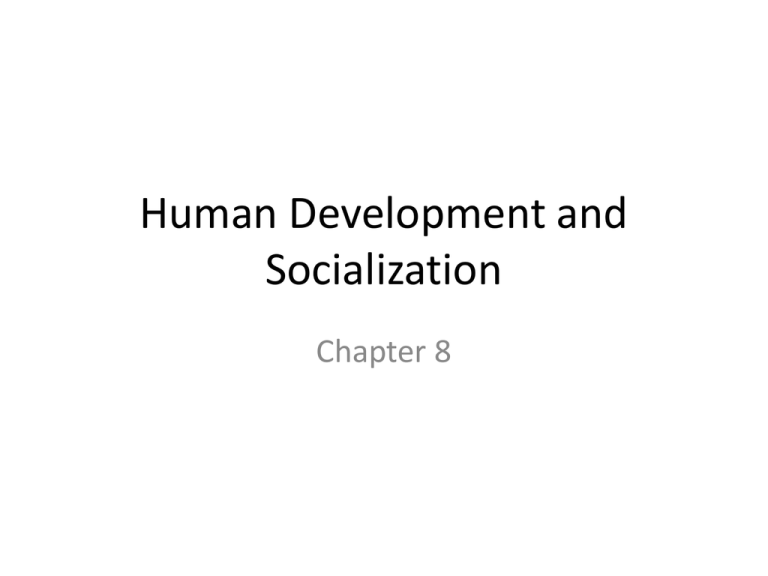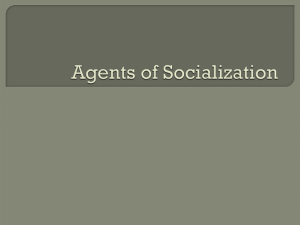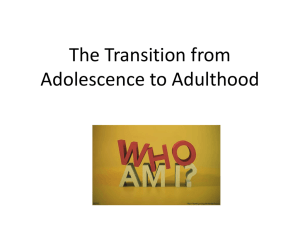Human Development and Socialization - Klicks-IBPsychology-Wiki
advertisement

Human Development and Socialization Chapter 8 Development and Socialization – Human Development • The changes in physical, psychological and social behavior that are experienced by individuals across life span • Growth, decline and modification – Socialization • Process by which the individual becomes a member of a particular culture What impacts child development • Quality of life – – – – Access to food Living condition Quality of education Violence • Family size – Western families-nuclear family – Non western – extended family • Technological advancements/socioeconomic improvements What impacts child development – Studies – Knight and Kagan • Showed that 2nd and 3rd generation Mexican American children had slower frequency of altruistic behavior compared to their 1st generation Mexican American peers who are less economically advanced – Vygotsky • Showed that kids with more intelligent parents are quicker to advance intellectually – Rogoff • Showed that in working class communities and preindustrial communities, parents tend to assume that children can learn things on their own Norms, Customs, and Child Care – What impacts child development/socialization • Who they play with • Where they spend their time • What the child’s role is – People living in collectivist countries have authoritarian styles of parenting – Strict demands, behavioral control – African cultures value obedience while Western cultures condemn most forms of adult-child coercion Norms, Customs, and Child Care – Children roles • Dependent on gender – Girls are more likely to stay close to home – Boys are more likely to be independent • Dependent on culture – Muslim families discourage rough-and-tumble play – Thumb sucking is considered wrong by white South African mothers – Japanese women do not leave their kids with sitters » Reason why Japanese boys have a higher rate of anxiety when their parents are not their (Bornstein & TamisLeMonda) Parental Values and Expectations • Developmental timetables – Expecting your children to acquire certain characteristics by a certain age – Cultural differences • Development of skills – Israeli of European background mothers expected their children to develop cognitive skills earlier than those of non European background – US mothers expected their children to become assertive earlier than Japanese mothers – Study between 175 mothers from India, Japan and England » Mothers expected their children to be competent in different areas at different ages • Formal education – Chinese mothers were more willing to sacrifice for the sake of their children than US mothers were – European mothers stressed children’s self esteem and less motivation for education • Behavior – Study between 30 US and 30 Japanese mothers » Both emphasized social cooperativeness and interpersonal sensitivity » US mothers were strict about aggression and disruptive behavior » Japanese were strict about social insensitivity and uncooperativeness Erikson’s Stages of Psychosocial Development • All humans pass through eight developmental stages from birth to death – Stages are characterized by a developmental conflict • Positive resolution, personal ego is strengthened-> healthier personality • Negative resolution, personal ego is weakened-> unhealthier personality • Healthy person – Hope, will, purpose, competence, fidelity, love, care, wisdom • Need for encouragement of growth in virtues the person is missing • Criticism – Mixes objective description with subjective prescription Piaget’s Stages of Cognitive Development • Stages – Sensorimotor stage • When infants learn about their interaction with environment – Preoperational stage • Development of language acquisition – Concrete • Logic • Understand that volume, amount and weight may stay the same despite physical changes – Formal operations • Ability to think abstractly Opinions on Piaget’s Theory • Dasen – Suggests that the sequence is universal across cultures • People think that the methods used to conclude the stages is unreliable – People had limited understanding of the languages they were testing for – Accurate birth dates were not available • Ability to make practice decisions is not explained by this theory • Some believe formal operational stage is not achieved by all adults in all societies Stages of Moral Development According to Kohlberg • Preconventional Level – Stage 1 - Based what is wrong and right on fear of punishment – Stage 2 – Moral conduct produces pleasure, whereas immoral conduct results in unwanted consequences • Conventional Level – Stage 3 – Behavior is good if it is approved by significant others – Stage 4 – Laws determine what is moral and immoral • Postconventional Level – Stage 5 – Behavior is based on individual rights and social circumstance – Stage 6 – Behavior is regulated by universal ethical principles that may rise above the law Opinions on Kohlberg's Theory • Snarey – Saw that first two stages appear to be universal • Methodology of testing might have been unreliable – Hypothetical stories only related well to US subjects • Developmental stages are linked to values of liberalist western societies • Ma and Cheung – Saw that different cultures value each stage of moral development differently – Chinese – traditional norms, conformity to primary groups – Western – individual rights, protection of the law Developmental Stages • Classification – Life events • Birthdays, weddings, graduations, job promotions – Biological, behavioral and physiological changes • Permanent teeth, first words, first menstruation, menopause, grey hair – Symbolic events • First intercourse, reaching the drinking age – Age • Prenatal period, infancy, childhood, adolescence • Classification may change depending on culture Life before Birth: Prenatal Period – Things that can impact development • Hunger, violence, radiation exposure, pollution, lack of professional prenatal care – Attitudes toward pregnancy • Traditional collectivist countries – Family centered with guidance from family • Individualist societies – Childbirth is more private • These classifications are very general though First Steps: Infancy • Infant mortality varies from country to country – Depends on socioeconomic and political conditions • US – 6.7/1,000 • Afghanistan – 144/1,000 • Child temperament – Genetic basis – Environmental basis • How a parent responds to their child crying – US – uses words – Kenyan/Bostonian – touch, hold or talk • Recognition of people – Most infants develop attachment around 7 months – Attachment patterns • Anxious and avoidant – Children do not pay attention to their parents – Western European countries • Anxious and resistant – Children stay close to parents – Non- Western countries • Securely attached – Children are more threatened by a strangers First Steps: Infancy • Right-handedness – Prevalent in all cultures – genetic – Some practices force children not to be left-handed • Motor development – Use of difference techniques – Africans develop motor skills before white children • Brest feeding – Industrial nations breast feed less • Availability of formula, freedom of choice for women to decide • Language development – What you are exposed to impacts ability to make sounds – Japanese - difficulties pronouncing L’s – Russian – difficulties see difference between i and ee Discovering the World: Childhood • Childhood- period of continuous growth, learning and development – Early years – wishful thinking, fantasy, magic – Middle childhood – more abstract but still based on observation and direct experience • Easier to understand war than peace – Domino and Hannah • Children tell stories based on what they are exposed to – Chinese – authority, moral rectitude – US – more physical aggression – Eating • Cross cultural - coaxing children into eating • Differences – Muslims do not eat pork – Hindu may never try beef – Europeans avoid dog’s meat Discovering the World: Childhood – Sleeping • Cosleeping – Indian Mexicans • Separate bedrooms – US and Western mothers – Play • Cross cultural – encouraging cooperation, sharing and competition • North America – More competitive – Suppression-facilitation hypothesis • Behaviors that are discouraged in a culture will be seen infrequently in mental health facilities • Behaviors that are rewarded will be seen excessively • Evidence to support this from Weisz experiment Major Rehearsal: Adolescence • • Adulthood – developmental stage and cultural phenomenon Characteristics of adolescence – Cross-culturally • • • • Weight and height Women mature earlier than men Formal thinking replace concrete thinking Thinking – • Contradiction, unpredictable assumptions, sudden turns, rebellion Social and political conditions – Studies • Horowits and Kraus – – – • Fraczek – – • North American students are peer-group oriented Soviet Union students were teacher oriented Explanation – USSR had a stronger emphasis on discipline Poland (socialist at the time) reported more aggression in their attitudes than those of Dinland Explanation - Polish lived in a state of emergency and violence during that time Elbedour – – Jewish adolescents expressed less of a need to control or to conform to their friends than Bedouin adolescents Explanation – Individualist vs. Collectivists Adulthood • • Def – represents maturity, responsibility and accountability Persistence vs. openness – – – • Persistence – Behaviors learned early in life do not change later Openness – people change their attitudes and behaviors in effort to adjust to changing situations Conclusion – openness Development of identity – – Def – view of themselves as individuals and members of society Identity is based on culture • • • Education’s impact – – People start waiting long to have families Emerging adulthood • • • Traditional societies – accept their identity in the systematic and coherent environment Western societies – offer individuals a wide range of options Period from late teens to mid-twenties Characterized by self-focused exploration Wisdom of adults – Fluid intelligence – ability to form concepts, think abstractly and apply knowledge – Crystallized intelligence – accumulated knowledge and experience • • In western societies this is looked at as an indicator of success In non-Western societies, this is looked at as an indicator of success Late Adulthood • Characteristics • What makes one classify as being in late adulthood – – – Skin becomes less elastic, hair loss, bones become brittle, cardiovascular system becomes less efficient. Retirement, giving up major family responsibilities Cross culture • • • • Life expectancy – – • Japan/Switzerland – 80 Nigeria/Bangladesh/Chad – lower than 60 Social status – – – Collectivist cultures – elderly have high social status Individualist cultures – elderly are isolated and rejected Yu – Fuligni and Pedersen • • • – Showed that respect of elderly is higher in Japan and China than it is in the US Examined 745 ethnically diverse group of US individuals from secondary school to adulthood Sense of family obligation increased as they moved to young adulthood Elder and Conger • • US – retirement age is 65 Russia – retirement age is 55 Norway – retirement age is 70 Showed that familial support among teenagers increases during economic crises Understanding death – – – Early childhood – time is limitless Early adulthood – realizing time is scare Middle age + - time is seriously limited








